Last year I was fortunate to be able to get involved with the ZSL eel monitoring in the Thames project which gave me my first real ‘hands on’ experience of conservation. It also encouraged me to read around the issue a lot more and now INJAF is delighted to be supporting World Fish Migration Day to help do our bit to raise awareness of the plight of various migratory fish species.
The eel monitoring took place in the River Hogsmill a few hundred metres upstream from where the river flows out into the Thames. Having learnt about the barriers to migration faced by the eels I was much more aware of how much the Hogsmill has been adapted and developed by the hand of man, and the negative impact this has had on the species and biodiversity of the area.
So when I read the Kingston University biodiversity blog a few weeks ago, and discovered a call for volunteers for a habitat improvement project on the Hogsmill I signed myself up at once! The project was a great opportunity to get involved in some conservation which will help support a critically endangered species as well as to learn more about the ecosystem of the river and the issue of migratory connectivity. I was also fortunate to attend a lecture at Birkbeck University a few days after my turn at the Hogsmill. The lecture was about wetlands management and was perfectly timed as it helped put the Hogsmill project in context with the bigger picture, as well as teaching me a lot more about the processes involved in river management.
This article is going to be a bit of a mix of me reporting back on my time on the project combined with other information from the Birkbeck lecture, fish migration and migratory connectivity, some of the various legislation and Acts relating to waterways and a couple of case studies of other areas where river management has already paid dividends. Hopefully you’ll find it interesting! It might get quite long as I add updates on how the riverbank is developing, so I’ve added some links here to help you jump straight to different sections of the article.
Links
The Hogsmill Habitat Improvement Project
Building the new riverbank
Planting the riverbank
Update: May 2014
Update: June 2014
Update: July 2014
Update: August 2014
Getting involved in conservation and volunteering
Migratory connectivity
River and wetlands management
River management case studies
Further reading
The Hogsmill Habitat Improvement Project Return to top
The project was run in conjunction with the South East Rivers Trust and focussed on an area in the Knights Park Campus. It’s part of a bigger project being undertaken by the South East Rivers Trust to improve the Hogsmill, there’s more information on the rest of the project on the South East Rivers Trust’s Hogsmill blog. The habitat improvement project at Knights Park comprised three stages, one to stake out timber into the river to start altering the way the water flows, the second to add more timber, brash and gravel to the area next to the concrete bank to build up a ‘fake’ river bank, and the third to plant the new river bank with native marginal plants.
There are several concrete weirs within the few hundred metres from the mouth of the Hogsmill to the eel monitoring site, and the river channel itself has been modified so that it is mostly a deep concrete channel fenced off from the public. The area we would be working on has a concrete bank on one side, although there is a more natural bank on the other. Closer to the mouth of the Hogsmill the channel is almost entirely concrete, so every little bit of re-naturalisation helps. The channel is quite wide, probably wider than it would naturally be, so it can get quite shallow in summer, but can also turn into a torrent during times of flood as the base of the channel is relatively uniform.
Altering the flow
The first stage to alter the flow of the river has several reasons behind it. By providing areas where the flow is different it’s possible to encourage a greater degree of biodiversity as the different areas naturally appeal to different species for different reasons. Large timbers were laid lengthways into the river. This causes the water to flow over them and then down, creating areas of mild turbulence. This helps scour the base of the river and encourages gravel and silt to move downstream thus creating deeper pools on the downstream side of the timbers. The Hogsmill is home to various species of fish, such as chub, and the deeper pools will act as nurseries for the fry and youngsters.
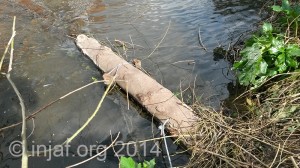
The timbers also encourage the river to meander from left to right instead of rushing along in a straight line. This provides more opportunity for the banks to accumulate silt which can then be colonised by plants thus helping to reinforce the banks from the process of erosion as the plants’ roots create a network which holds the earth in place. Making the river meander helps slow the flow a little, reducing the ‘biological wash-out’ often experienced by heavily engineered waterways during times of flood. Biological wash-out refers to the result of the flow being so powerful that it literally swooshes everything along the river with it leaving little remaining.
Building the new riverbank Return to top
The new riverbank is approximately seventy metres long, and building it was no mean feat. The level of the Hogsmill rises and falls by several inches during the course of the day, with more than one peak flow. Toby Hull, from the South East Rivers Trust, explained that the rise in water level around 10.00-11.00hrs was a direct result of everyone in the local area having had their morning showers etc. The additional flow was coming from the sewage treatment plant upstream. There is another peak flow around 20.00hrs after many people have returned home. This meant it was important to judge how deep to build the new bank. Too shallow and it would be swamped during high flow, too tall and it would be in danger of drying out as flow reduced. Toby’s expertise in calculating all the different variables came in very handy here!
The first stage of the project was to stake timber out along the river. I wasn’t able to attend this session but the team worked hard and the large timbers were secured safely.
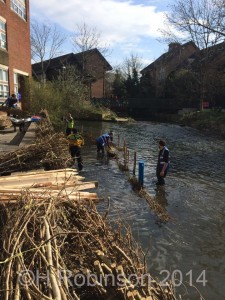
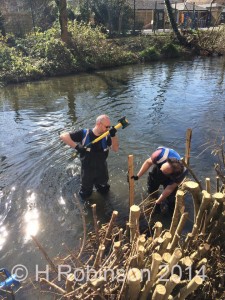
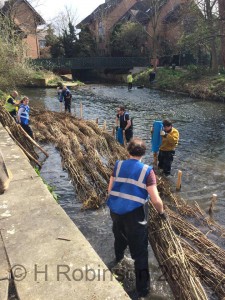

I was able to attend day two, on 16th March, of the three-day session to stake out the shape of the new bank and fill it with gravel and brash though, and could already see the river’s flow had changed due to the timbers. When I went on the Sunday we were given a health and safety talk before getting started. Even innocent looking rivers like the Hogsmill can be dangerous if not taken seriously and none of us fancied re-enacting Millais’ ‘Ophelia’! Waders were a must for anyone entering the water, it was remarkably cold even though the sun was nice and toasty.

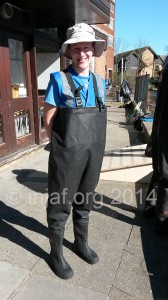
The Saturday group had worked their socks off but there was still much to do. Sunday was blazing sunshine all day and it was hot work despite being mid-March. Spending the day outside in such lovely weather was just, well, lovely! It felt like summer was just around the corner after all, quite enough to lift the spirits. We set to work shifting the huge pile of gravel from the car park along to the site, a hundred metres or so away. Ben, the digger driver, had perfected the art of filling multiple wheelbarrows at once and we soon had a constant supply of gravel heading to the river.
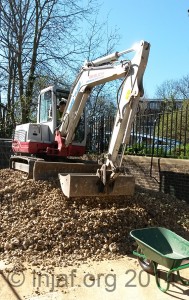
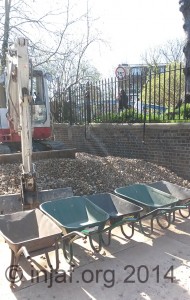
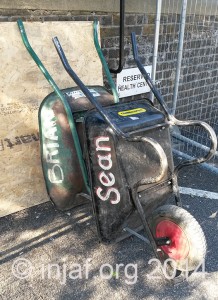
Other volunteers carried on staking out the new shape of the bank and securing brash in place, the gravel shovellers followed on their heels filling in the rest.
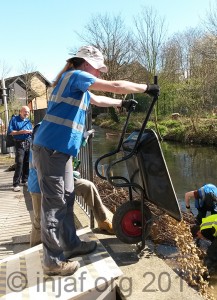
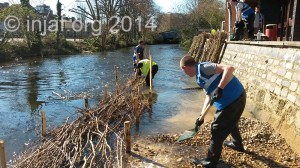
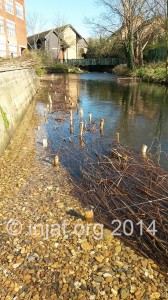
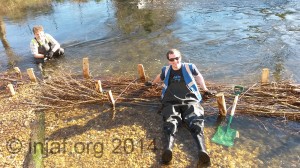
The Sunday team made great progress and the final shift on Monday launched into action to finish off the gravel moving, even it all out, and finish wiring and staking everything in place. Signs were put up explaining what the project was all about.
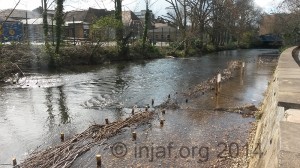
The final stage: Planting Return to top
We now had to leave the bank for a few weeks to allow it all to settle down and to allow time for silt to accumulate among the gravel and brash. The next stage of the project was to add several species of UK native marginal plants to the bank. The plants roots would help provide structural integrity to the bank, and provide further networks for silt to gather in. The new bank is artificial so it’s important to build it in such a way that it can develop into something that could have occurred naturally had the channel not been altered so much. The plants will encourage a wider variety of insects and invertebrates; in turn these will help attract more wildlife such as birds and bats. I was dying to see it all come together so on 2nd April I took a day’s leave from the office and went to lend a hand.
There was a good turn out again including staff, students, local residents and members of the South East Rivers Trust and The Conservation Volunteers. Which was just as well considering we had 1000 plants waiting to go in!
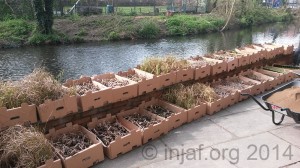
Once again the weather was on our side, a few large raindrops plopped into the river mid morning but soon moved on to somewhere else leaving us in the sun again.
The smaller plant species were put into little hessian bags as groups of three with a scoop of soil. The bags were then wedged into the brash to keep them secure and stop the baby plants being washed away before they got a grip. With several hundred plants to be bagged we soon worked out a production line, which drew lots of interest and comments from passing students who were all very positive about the work we were doing.
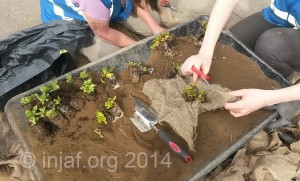
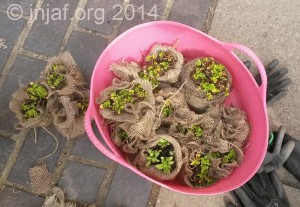
The plants were set out along the bank to make sure there was an even spread. Some are best suited to shallower water while others prefer to be a little deeper. They were laid out accordingly and, a few rearrangements later, were finally all in place. There is a social area for students near the river and many of them commented on good it was looking, a nice compliment for the work we’d done.
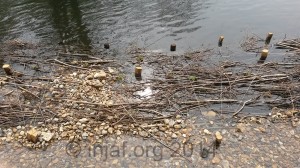
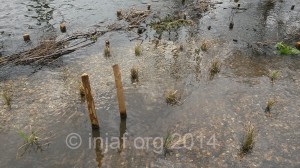
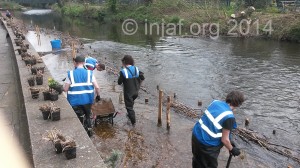
The final job was to install a chicken wire fence on the river side of the bank to prevent ducks and other water birds from making short work of the baby plants. We also set up a plastic mesh fence on the bank side to catch any wayward litter. Both will be removed once the plants have established.
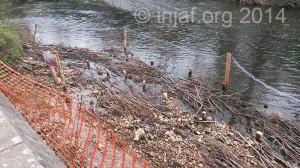
The only thing to do now is wait and watch as the plants develop and the wildlife is tempted in.
Updates
I’ll be updating every month with photos showing how it’s all getting on so keep an eye out for future updates.
May 2014 Return to top
The tiny plants we put in have been growing brilliantly! They seemed so small and vulnerable when we planted them that it was hard to imagine how well they’d be doing a few weeks later. These photos were taken at the beginning of May, and you can clearly see how much the plants have grown. The marsh marigold is now flowering and there are lovely yellow flowers adding a spot of sunshine to the bank. The fences are still in place as the plants are still vulnerable to ducks and other water birds. but at the rate they’re going they’ll soon be able to hold their own and the fences can be removed.
The bank is also building up a good covering of silt, which will help the plants develop a good root system. There’s a lot of algae too but this is only to be expected in shallow, well lit water with a high nutrient content. The plants will gradually take up more of the nutrients as they get bigger, and the algae will find it has a little more competition.
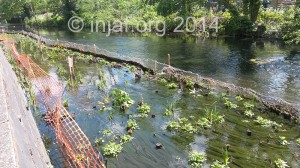
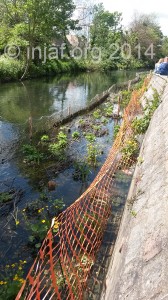
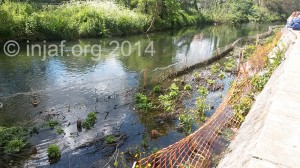
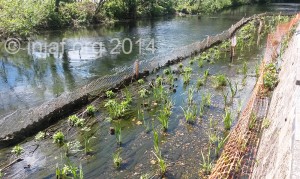
June 2014 Return to top
The sun wasn’t shining quite so brightly when I went back for some photos for this update, but this wasn’t deterring the plants who were very much getting into the swing of things. The irises were flowering, as were some of the water forget-me-nots, and many of the plants are starting to look nice and bushy. The gaps are filling in nicely, although the downstream end of the bank is slightly sparser than the upstream end. The water here is a little deeper over the plants and they are taking a bit longer to establish and thrive. The algae that was in evidence in May doesn’t look quite so lush now, the plants are spreading out more and taking a lot of the sunlight making it harder for the algae to grow. It’s remarkable to think that only a few weeks ago they were tiny little plug plants which looked completely lost in the riverbank. There were several ducks and a moorhen loitering about when I arrived, sadly they were a bit camera shy!
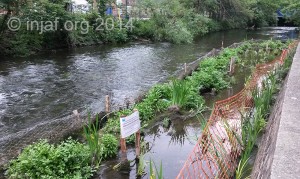
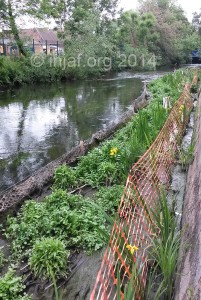
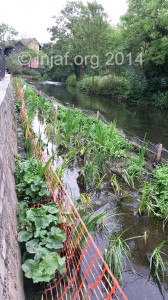
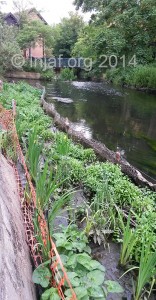
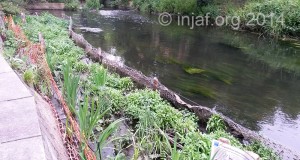
July 2014 Return to top
A small confession, it appears the July photographic update ‘may’ have been overlooked. However, on 30th June (which is almost July!), a few volunteers met up again and spent the afternoon adding a few new sedges to fill in some gaps on the downstream end where some of the originals hadn’t taken as well as the others. Most of the plants were doing very well indeed, the flag irises had just flowered and a few sunshine yellow flowers were still clinging on. The watercress and fools watercress were going great guns, so much so that we had to prune them back to avoid them smothering some of the other plants. Some of the gravel was still visible, and it was still possible to see water around some of the plants.
August 2014 Return to top
August has seen some heavy rain showers in a classic ‘sunshine and showers’ British summer scenario. Perhaps I should have borne the ‘showers’ element in mind a little more when I headed over to Knights Park one lunchtime but the sun had come out and I decided to chance it. The riverbank was a solid swathe of green this time, all the plants were in full swing and there was hardly a stone to be seen. All the gaps had filled in and the wildlife had started to make the riverbank its home. The protective fencing has been removed and an adult moorhen with a pair of young were stalking about in the leaves. There were also butterflies over the bank, this is encouraging as it shows the bank is acting as a ‘highway’ for them.
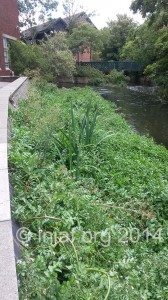
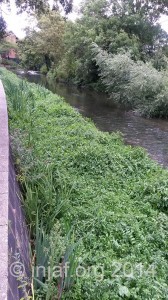
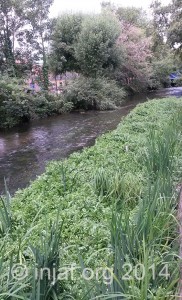
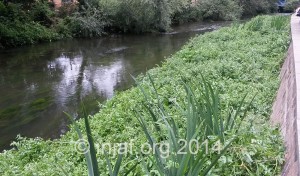
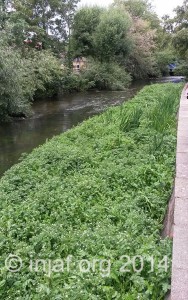
The last photo shows the aforementioned moorhen, if you look closely, right in the middle of the photo, it’s stalking about in the greenery!
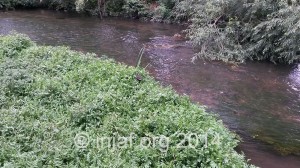
So, about that sunshine and showers thing … shortly after i took these the heavens opened and it rained in quite some style! Happily the reception staff at Knights Park lent me an umbrella from lost property, and a tree provided a degree of shelter when the rain upped the ante a little further! Despite the soaking I received it was great to see the riverbank flourishing and providing a home for wildlife, makes all the work we all put in seem very worthwhile.
Getting involved in conservation and volunteering Return to top
If any of this has inspired you to want to get involved in something similar check out our article on getting involved in conservation and volunteering for more information and ideas.
Migratory Connectivity Return to top
On the face of it, the term seems fairly self-explanatory, but the reality of migratory connectivity is far from straightforward. Various species have developed migratory routes over many years, parents teach their offspring the routes, and some animals just seem to know them, and navigate them by means that man doesn’t yet fully understand. The connectivity of migratory routes is under threat in many instances, mostly due to man’s intervention. Various schemes and projects exist to monitor these routes, and to try and promote understanding of why this connectivity is important. The Migratory Connectivity Project has more information on a variety of issues and species.
The European Eel, Anguilla anguilla, is a fine example of a species suffering from barriers in its migratory connectivity. Man has installed weirs and other barriers in many waterways, making it almost impossible for the eels to get upstream to the waterways where they spend their adult lives. This has a knock-on effect for other wildlife who rely on the eels for prey. Think of it as a game of Jenga; there’s only so many bricks you can take out before the whole thing collapses once and for all. Rebuilding it from scratch is a far bigger job than repairing the damage done before it becomes critically unbalanced.
World Fish Migration Day is working hard to raise awareness across the world of the plight faced by many migratory fish species. There have been many positive stories reported, dams being removed and fish passes installed in many places to reconnect the migration routes and bring back the missing biodiversity. But there is much to be done. A wider understanding of the issue will help those responsible for managing the environment to find the most suitable and mutually beneficial means to do so. For more information check out the World Fish Migration Day website, and don’t forget to have a look at the events page to see if there is anything happening near you.
River and wetlands management Return to top
I recently attended a lecture at BIrkbeck University, London, called “River and Wetland Management: Unleashing Nature” and given by Dave Webb of the Environment Agency. The lecture was part of the free lectures for the Spring Series 2014: Management of wildlife habitat, run in conjunction with the Linnean Society of London. The Linnean Society is named after Carl Linnaeus, a Swedish botanist and zoologist who developed the Latin, or scientific, naming convention to definitively identify species and avoid the confusion created by a plethora of common names.
Dave Webb is a biodiversity technical specialist working for the Environment Agency. The lecture covered the different methods of river and wetland management seen in the UK over the last twenty years or so.
The two biggest issues facing wetlands today are the impacts of human activities and the impacts of climate change both of which can be at least partially offset by effective management. Over the last ten to twenty years, ecology and river management has developed an increasing recognition of the biological and physical processes involved in ecosystems.
Dave described the old practice of flood defences as being to maximise conveyance, i.e. how fast the water moves. Concrete beds and channels can assist with this (as seen in the Hogsmill). The idea being that water needed to be moved away from the scene of potential flood as fast as possible.
The public was actively kept away from rivers, which in a sociological sense caused detachment and lack of engagement. This has been found to increase anti-social behaviour such as fly-tipping as there was little care for an environment no one could interact with.
However, the last twenty years has seen a huge increase in community involvement in river management. Direct community action has been very beneficial as its helped restore peoples’ relationship with the sites, and their engagement with the environment on their doorsteps.
Variations in flow are important for improving/reducing silt loads in gravels etc. Vegetation can help maintain flow during drought by allowing siltation and plant colonisation thereby narrowing the channel the water flows through. This provides increased velocity which helps maintain the flow of water and in turn keeps the waterways connected. Lengths of very shallow water provide an obstacle to migration. Areas with a maximum of five centimetres deep over twenty metres or more makes the area impassable, as well as making it prone to temperature variations (just like rock pools on the beach). A ‘proper’ riverbed can provide somewhere for life to hole up until the flow comes back; this aids re-colonisation in times of drought.
Flooding can also be mitigated, and even avoided with appropriate thought given to the entire river system. Toby Hull explained this further during the Hogsmill project. ‘Upstream management’ can involve various things, one example being to maintain planting along riverbanks in the upstream part of the river. Planting reinforces the riverbanks and prevents erosion, as well as helping the land remain stable when taking in a lot of ground water or over flow. If the river is prevented from building up too much flow from the outset, the lower levels will be less likely to suffer from deluges in times of high rainfall.
The recent flooding in the winter of 2013/14 caused quite a lot of debate around the subject of river and wetlands management. Times of crisis can unfortunately be a catalyst for some short-term thinking as Government attempts to appease a distressed public. If real progress is to be made, and future problems managed and averted there is a need for more long-term ‘bigger picture’ thinking. This means there needs to be a greater understanding of how the entire river system works, from the tiny mountain springs hundreds of miles away, to the huge estuaries opening out into the sea. Each section of the river has its part to play in flood management. The key to sustainable development is understanding the different uses of an environment in order to develop an integrated approach to its management.
The Brundtland Report 1987 (by the Brundtland Commission) effectively defined sustainable development and provided the foundations to build on which are referred to today.
The focus of river and wetlands management is now on resilience and adaptation rather than maintaining a steady state. The traditional approach of concrete channels and underground rivers is no longer acceptable; it’s now more about integrated systems and increasing complexity of structures and habitats.
River management case studies Return to top
Sutcliffe Park 2005 – Quaggy project
Deculverting work in a Greenwich park was undertaken to reduce flooding in Lewisham. This resulted in a massive increase in park usage despite initial misgivings by Greenwich residents over changing their park for the benefit of people elsewhere. Deculverting involved ‘digging up’ the river from where it had been banished to an underground concrete culvert and creating a natural channel in the park for it to flow through. Instead of water rushing along the concrete channel and overflowing in Lewisham the water can now meander along the natural riverbed, excess water can overflow onto the surrounding flood plains and drain away gradually.
Quaggy Waterways Action Group: Flood Alleviation Scheme
Forest Research: Sutcliffe Park Flood Alleviation Project
Chinbrook Meadows
A similar project was undertaken at Chinbrook Meadows which resulted in less anti-social behaviour being reported.
Milton Keynes
The city has a built in system of flood defences known as the balancing lakes. Water is diverted in times of flood into lakes with a large capacity for taking up excess water from the surrounding area. The outflow is then managed carefully to ensure minimal impact. The balancing lakes do sometimes overflow, during the recent floods the ones at Willen rose up over their banks, but this overflow was taken up by the surrounding parkland and the residential areas were safe. Milton Keynes is a good example of planned river and wetlands management being integrated into residential areas.
Milton Keynes balancing lakes
Willen Lake, Milton Keynes
Further reading Return to top
There is a vast amount of legislation and policy regarding river and wetlands management, I’m not going to go into detail about them all here as that’s practically a thesis in itself! But if you’d like more information have a look through the links below, hopefully this will be a useful resource for anyone interested in river and wetlands management. As well as policy and legislation information, there are also some links with information about habitat restoration in the UK and beyond:
Biodiversity 2020: A strategy for England’s wildlife and ecosystem services
England Biodiversity Indicators
EU Water Framework Directive and more info from the EA Environment Agency: Introduction to the Water Framework Directive
Wildlife and Countryside Act 1981
Environment Act 1995
Countryside and Rights of Way Act 2000, Section 74
Natural Environment and Rural Communities Act 2006, section 40
The London Plan
Blue Ribbon Network Policy
All London Green Grid
London Biodiversity Partnership
London Rivers Action Plan
London Rivers Action Plan map
The River Restoration Centre
Thames River Basin Management Plan
Wetlands International
The Ramsar Convention on Wetlands
Handbook on Best Practices for the Planning, Design and Operation of Wetland Education Centres
Recommendations for the post 2015 Hyogo framework for action (HFAII): Calling for increased attention to the need for integrated water and wetland
management to reduce disaster risk (from www.wetlands.org)
European Centre for River Restoration (ECRR)
ECRR Projects: River Restoration
Freshwater Habitats Trust: Water Friendly Farming
The river Geronimo knew – wetlands habitat restoration on the Arizona/Mexico border
Searching for water on the San Pedro – mapping water flow in Southern Arizona
UK flooding: How a town in Yorkshire worked with nature to stay dry
Author: Suzanne Constance
Photos courtesy of Helen and Kyle Robinson, and Suzanne Constance





Pingback:» Urbantrout sidecasts: Monday 19 May